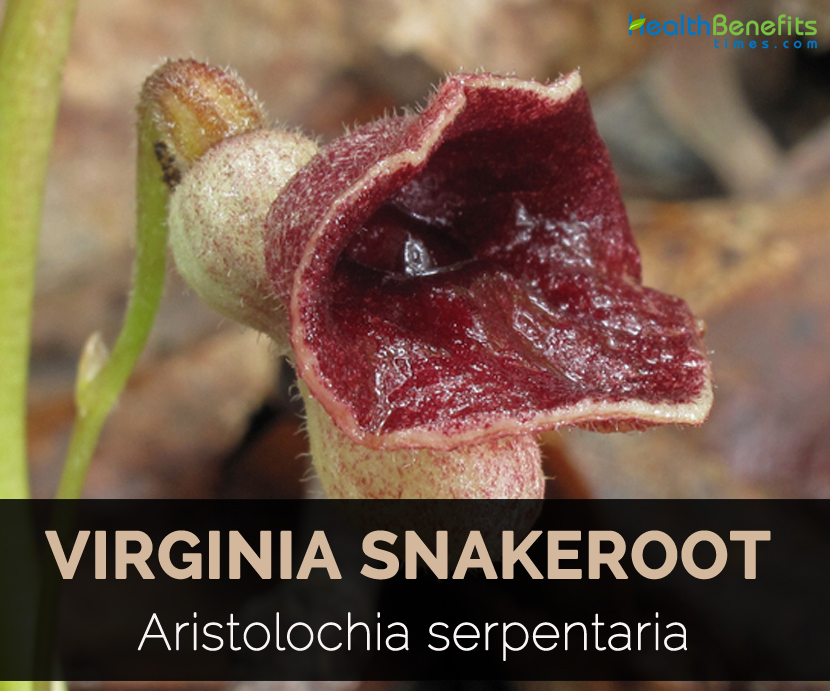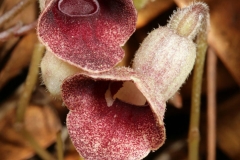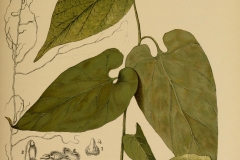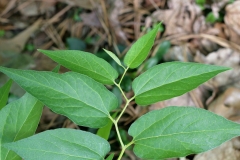Virginia snakeroot is a rhizomatous perennial which blooms in June and bears capsular fruits in July. Flowers lie near the ground and are dark red at mouth and mimic carrion. The genus is characterized by an elaborate pollination mechanism in which inwarpointing hairs in the floral tube allow entry but not retreat of pollinators. Once pollen is shed on the imprisoned insects these hairs wilt and freeing them to find and fertilize another plant. Virginia snakeroot also bears small, closed and self-pollinating flowers.
Facts About Virginia Snakeroot
| Virginia Snakeroot Quick Facts | |
|---|---|
| Name: | Virginia Snakeroot |
| Scientific Name: | Aristolochia serpentaria |
| Origin | Native to eastern North America, from Connecticut to southern Michigan and south to Texas and Florida. |
| Name | Virginia Snakeroot |
|---|---|
| Scientific Name | Aristolochia serpentaria |
| Native | Native to eastern North America, from Connecticut to southern Michigan and south to Texas and Florida. |
| Common/English Name | Red River Snake Root, Sangrel, Texas Snake Root, Sangree Root, Birthwort, Serpentaria |
| Name in Other Languages | English: Virginia dutchman’s pipe, Virginia serpentary, Virginia snakeroot, Serpentary, Snakeroot |
| Plant Growth Habit | Herbaceous perennial |
| Plant Size | ½–2 feet tall |
| Leaf | Heart-shaped |
| Flowering Season | Late spring or summer |
| Flower | Pipe-shaped, ½–¾ inches in length |
Health Benefits of Virginia Snakeroot
- Cure for snakebites
It is effective for treating snakebites. Native Americans use it for treating snake bites by chewing the root of the plant and sucking out the snake’s venom from wound then applying the chewed root.
- Relieve cold symptoms
It is the prominent and perceivable effects of Virginia snakeroot which induces heavy perspiration. It is the most used alternative diet drink as heavy perspiration encourages people to drink more water in order to compensate for the lost liquid. Aristolochine compounds in the plant affects the kidney function heavily. Intake of Virgina snakeroot provides relief from cold symptoms.
- Boost appetite
Snakeroot plant is the perfect solution for those who want to gain some weight. It stimulates the secretion of gastric acid. Increase in gastric acid will signal entire body that it requires more stuff to digest. This is the reason noises of stomaches are taken as a signal for hunger. The noises are caused by the movement in intestines partly caused by secretion of gastric acid.
- Menstrual health
Snakeroot is used as an ingredient for traditional Chinese medicine. It helps to increase the blood flow and has beneficial effects. It is useful for women during menstruation or for those having problem of keeping the menstruation cycles regular. It is believed that acids found in the plant work in the similar way to that of snake’s venom. The effect of snake’s venom is inducing excessive blood flow by slowing
- Acts as natural aphrodisiac
People have been using chemicals including toxins for the benefits such as improvement of health, treating diseases and even to enhance their current condition. People have been prescribing Snakeroot as an ingredient for aphrodisiac and also as potent stimulants for various bodily functions. The intake of snakeroot causes the increase in bloodflow.
- Improve blood circulation
Virginia snakeroot improves blood circulation which is useful for various purposes. Proper blood circulation is a prerequisite for good overall body health. Intake of dried snakeroot leaves as tea helps to stimulate blood circulation as leaves has flavonoids which is a common substance found in tea leaves. Flavonoids has beneficial effects in cardiovascular function such as reducing blood pressure as well as atherosclerosis.
- Treat convulsions
Convulsions involves involuntary contractions of muscles and is associated mostly with brain disorders such as epilepsy and some toxins in the blood. It is not clear that how Virginia snakeroot actually works. Maybe the effect is explained by how aristolochic acids affect bloodflow which might induce secretion of toxins in blood through perspiration or urination.
- Cure rabies
Virginia snakeroot is helpful for treating rabies which is a disease caused by virus causing inflammations in brain of humans and other mammals. People uses Virginia snakeroot for curing this disease. The presence of anti-inflammatory effect might be the main factor for lowering inflammations in brain.
- Treat skin problems
Some skin problems are caused by inflammations such as rashes and eczema. Both chemical and traditional medications are prescribed for treating these skin problems. Virginia snakeroot is the effective method for treating this health problem. Virginia snakeroot has anti-inflammatory properties and flavonoids contents which make it beneficial for treating skin problems.
- Improves digestion
Aristolochic acids suggests that acids stimulate the gastrointestinal tracts by speeding up the digestion process and even tones the digestive system in the bodies. This is the main reason why this plant is popular as an ingredient for traditional diet supplements and diet tea.
Uses
The action of Virginia snakeroot is so prompt that it has a great reputation for snake bites, hence its name. This is a pure stimulant whose action is mainly employed in diverting the flow of blood outward; and for this reason it is largely employed in eruptive diseases before the appearance of outward manifestations are noticed. It rids the system of any offending matter by producing perspiration and supporting the vital forces. As a nerve stimulant it acts very promptly and is much used in depressed or exhausted conditions of the nervous system, especially in the latter stages of smallpox, scarlet fever and pneumonia. The influence on the circulation will also be felt by the whole arterial system as the heart’s impulse becomes stronger and fuller. The often suppressed menstruation due to colds will be brought about by 5–10 drops of V. snakeroot tincture in Pennyroyal tea. Also for cold extremities of hands and feet due to general receding of blood from the surface. The cold infusion is used for strengthening purposes and it may be drunk freely and is often employed with good effect in dyspepsia, croup, throat and kidney congestion and renal torpor. In proper doses it stimulates appetite and digestion in indicated conditions. In large doses, however, it is irritant, causing vomiting, vertigo, purging, etc.
Dose
Of the tincture, 5–20 drops three times daily. As an infusion, 1 teaspoonful of the granulated root to 1 cupful of boiling water, steeped 30 min. Take in tablespoonful amounts three to six times a day.
Homoeopathic Clinical
Trituration of dried roots—Dyspepsia, Flatulence
Medicinal uses
- It is used for various skin, circulatory and kidney disorders.
- Root is an antidote, bitter tonic, anti-inflammatory, diuretic, diaphoretic and stimulant.
- Chew it or use it as a weak tea for promoting sweating, stimulate appetite and promote expectoration.
- Native Americans use it as an infusion internally for treating pain, rheumatism, sharp pain in the breast and wash for headaches.
- Root extract is used for providing relief from stomach pain.
- Boiled root or decoction made from whole plant is used for treating fevers.
- Chew the root or apply the crushed leaves to snakebites.
- Apply it externally to slow healing of wounds and treatment of pleurisy.
- Place the bruised root in hollow teeth for treating toothache.
- Decoction of whole plant is used for treating fevers.
- Use the tea to gargle for sore throats.
Precautions
- When used in large doses, it causes nausea, griping pain in the bowels etc.
- Use it internally under the supervision of qualified practitioner.
- In case of allergic reactions being experienced, stop using it and seek for medical help.
References:
https://www.itis.gov/servlet/SingleRpt/SingleRpt?search_topic=TSN&search_value=18342#null
https://pfaf.org/user/Plant.aspx?LatinName=Aristolochia+serpentaria
https://en.wikipedia.org/wiki/Aristolochia_serpentaria
https://plants.usda.gov/core/profile?symbol=ARSE3
https://www.illinoiswildflowers.info/woodland/plants/va_snakeroot.html
http://medicinalherbinfo.org/000Herbs2016/1herbs/virginia-snakeroot/
https://drhealthbenefits.com/herbal/herbal-plant/benefits-of-virginia-snakeroot





